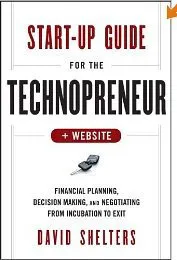[Book Review] Startup Guide for the Technopreneur: Financial Planning, Decision Making and Negotiating from Incubation to Exit
Wednesday May 29, 2013 , 6 min Read
by David Shelters, 2013 John Wiley, New York (Amazon) 8 chapters; 284 pages

His book serves as a thought-provoking guide that helps tech entrepreneurs avoid the planning and execution risks inherent in startups in general and the treacherous realm of venture capital in particular. The author draws on his insights and experiences to provide answers as well as further questions to entrepreneurs in their journey from incubation to exit.
The chapters are well structured and present a realistic picture to startup founders of what can be expected from prospective investors, how to craft a business plan from a strategic financial perspective, steps for successfully raising funds, and ingredients for negotiation. Sample financial plans, funding proposals, tables and checklists are included.
David Shelters has over fifteen years of entrepreneurial experience as a founder, cofounder, or financial advisor to numerous tech start-ups in both the US and Asia. Currently based in Bangkok, he provides financial advisement services through his company, Karon Business Consulting. He is also an active participant in the Thailand tech entrepreneurial scene, presenting at numerous BarCamps and other tech conferences. Shelters mentors several local software start-ups and is the in-house financial mentor at Hubba, a co-working space in Bangkok. He has a BA in history and political science from the State University of New York at Albany and an MS in international affairs from Florida State University.
The book is positioned as a mentor’s guide, helping startups think in strategic terms. The companion features the author’s blog and other resources such as a sample business plan, term sheet, due diligence checklist, and code of business conduct. I have summarised some of the book’s startup activities and checklists in Table 1 below.
Table 1: Strategic and financial planning for startups
Chapter 1 fleshes out the different types of funding options available, their control effects, equity dilution, alignment with shareholders, events on liquidation, and effects of exits.
Chapter 2 offers valuable insights into understanding investors. “Their primary objective is to make money. There are many types of investors, each with different expectations and capabilities,” Shelters advises. “Do not succumb to the mad scientist syndrome,” he urges techie founders; as much effort should be devoted to marketing as R&D of the product.
Startups should not just turn to investors for money, but also for alignment with shareholder interests, sharing of risk, and progressive attitudes towards control. The ideal investor is a strategic investor, for whom the venture offers a way to enter a new market more easily, leverage existing operations and investments, and gain competitive advantage.
The author warns startups to stay away from ‘vulture capitalists,’ who are looking for desperate startup founders and will structure agreements in such a way that the majority of the risk is assumed by the startup and most of the gains and control will go to the investor. There also some investors who have ulterior and even sinister motives, and may not always act in the best interests of the startup.
Chapter 3, on business plans, provides valuable advice on segmenting primary and second markets, direct and indirect competitors, positioning of disruptive products with respect to price and channel, and articulation of key milestones and timelines.
It is important for startups to make a full list of all possible risks; investors do not like nasty surprises. Worst case, best case and expected case scenarios should be spelled out.
Chapter 4 stresses the importance of fiscal discipline in addition to technical skills. A good analogy is made to fuelling issues during a road trip. Should you stop at every gas station? Should you stop only when you are almost out of gas? What kind of fuel and lubricants should you use? What about food supplies?
It would have been useful if the author cited more explicit case studies from the field, and also showed how to revise financial plans in the face of strategy pivots or after occasional failures along the startup journey. Still, startups will find this book to be an informative and sobering assessment of the hard work in the entrepreneurial journey.
“Your business plan should reflect the progression in your planning. If you devise and execute an effective financial plan, the consequent improvement in business planning, the periodic securing of funds on the most favourable terms at the optimal minimum amounts and timing will serve to maximise RoI upon exit,” the author concludes.
[Follow YourStory's research director Madanmohan Rao on Twitter]






